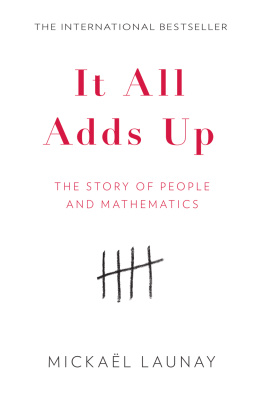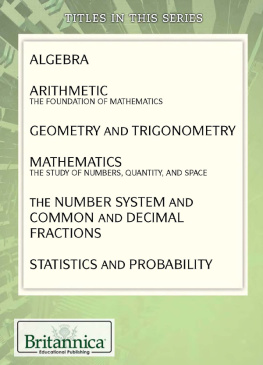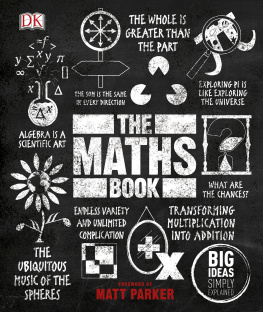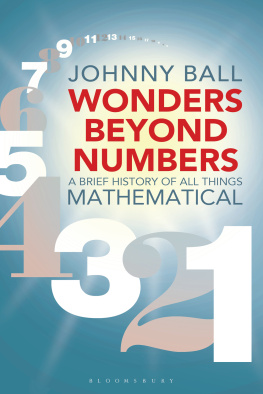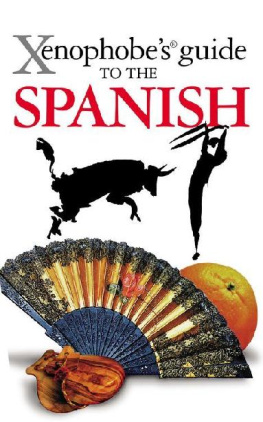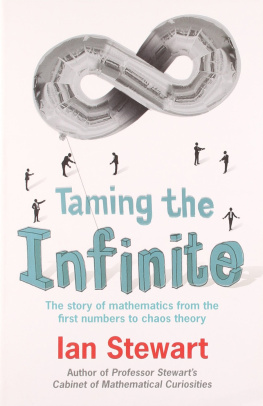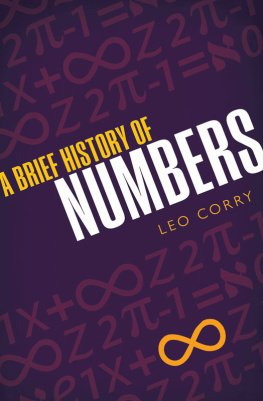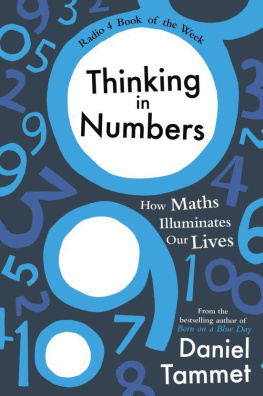
William Collins
An imprint of HarperCollinsPublishers
1 London Bridge Street
London SE1 9GF
www.WilliamCollinsBooks.com
This eBook first published in Great Britain by William Collins in 2018
First published in France by Flammarion, as Le grand romans des maths in 2016
Copyright Mickal Launay 2016
Translation copyright Stephen S Wilson 2018
Drawing by Stefan Zachow.
Mickal Launay asserts the moral right to be identified as the author of this work
A catalogue record for this book is available from the British Library
All rights reserved under International and Pan-American Copyright Conventions. By payment of the required fees, you have been granted the non-exclusive, non-transferable right to access and read the text of this e-book on-screen. No part of this text may be reproduced, transmitted, down-loaded, decompiled, reverse engineered, or stored in or introduced into any information storage and retrieval system, in any form or by any means, whether electronic or mechanical, now known or hereinafter invented, without the express written permission of HarperCollins
Source ISBN: 9780008283933
Ebook Edition October 2018 ISBN: 9780008283957
Version: 2018-10-09
Contents
Oh, Ive never been much good at maths myself!
Im getting a little blas. This must be at least the tenth time Ive heard that remark today.
But this lady has been here at my stall for a good fifteen minutes, standing with a group of other visitors, listening attentively while I describe various geometrical curiosities. Thats how the conversation started.
But what do you do for a living? she asked me.
Im a mathematician.
Oh, Ive never been much good at maths myself!
Really? But you seemed to be interested in what I was just talking about.
Yes but thats not really maths that was understandable.
I hadnt heard that one before. Is mathematics, by definition, a discipline that cant be understood?
Its the beginning of August, in the Cours Flix Faure in La Flotte-en-R, France. In this small summer market, I have a pop-up there is henna tattooing and afro braids to my right, a mobile-phone accessory stall to my left, and a display of jewels and trinkets of all kinds opposite me. Ive set up my maths stand in the middle of all this. Holidaymakers stroll peacefully by in the cool of the evening. I particularly like doing maths in unusual places. Where people arent expecting it. Where they are not on their guard
Cant wait to tell my parents I did some maths during the holidays! This from a secondary school pupil as he walks past my stall on his way back from the beach.
Its true I do catch them slightly unawares. But sometimes youve got to do what youve got to do. This is one of my favourite moments: observing the expression on the faces of people who thought that they had fallen out with maths for good at the instant when I tell them that they have just been doing maths for fifteen minutes. And my stall is always crowded! I present origami, magic tricks, games, riddles theres something for everyone.
No matter how much this amuses me, on balance I find it upsetting. How has it come about that we need to hide from people the fact that they are doing maths before they can take some pleasure in it? Why is the word so frightening? One thing is certain: had I put up a sign above my table proclaiming Mathematics as visibly as Jewels and necklaces, Phones or Tattooing on the stalls around me, I would not have had a quarter of the same success. People would not have stopped. Perhaps they would even have turned away and averted their gaze.
All the same, the curiosity is there. I observe this every day. Mathematics is scary, yet even more, it is fascinating. Some may not like it, but would like to like it, or at least to be able to peep at will into its murky mysteries. Many think it is inaccessible. But this is not true. It is perfectly possible to love music without being a musician, or to like to share a nice meal without being a great cook. Then why should you have to be a mathematician, or someone exceptionally clever, in order to be open to hearing about mathematics and to enjoy having your imagination tickled by algebra or geometry? It is not necessary to delve into the technical details in order to understand the great ideas and to be able to marvel at them.
Since time out of mind, innumerable artists, creative spirits, inventors, artisans, simple dreamers, or the purely curious, have done maths without being aware of the fact: mathematicians despite themselves. They were the first to ask questions, the first to undertake research, the first to brainstorm. If we want to understand the whys and wherefores of mathematics, we have to set out on their trail, since it all began with them.
The time has come to embark on a journey. Please allow me the space of these few pages to carry you with me into the twists and turns of one of the most fascinating and most astonishing disciplines ever practised by humankind. Let us set off to meet those who have created its story through unexpected discoveries and fabulous ideas.
Let us set out on a big adventure and see how it all adds up.
Back in Paris, it is at the Louvre Museum, in the heart of the French capital, that I decide to begin our investigation. Am I going to do maths in the Louvre? That may seem incongruous. Nowadays the former royal residence, converted into a museum, seems to be the domain of painters, sculptors, archaeologists and historians rather than of mathematicians. However, it is here that we can now hark back to the first traces of those same mathematicians.
From the moment I arrive, the appearance of the great glass pyramid that has pride of place in the centre of the Napoleon Courtyard is already an invitation to geometry. But today I have an appointment with a much more ancient era. As I enter the museum the time machine wakes up. I pass by the Kings of France and travel back through the Renaissance and the Middle Ages before arriving in Antiquity. The rooms spool by, I come across a few Roman statues, Greek vases, Egyptian sarcophagi. Still a little further to go. Now Im entering prehistory, and as I speed through the centuries I gradually need to forget everything: numbers, geometry, writing. In the beginning, no one knew anything. No one even knew that there was something to know.
The first stop is in Mesopotamia. We have travelled back ten thousand years.
Come to think of it, I could have gone back even further. I could have flown back another one-and-a-half million years, to the heart of the Palaeolithic, the Old Stone Age. Fire has not yet been tamed and Homo sapiens is only a distant prospect. Homo erectus reigns in Asia, and Homo ergaster in Africa, perhaps with other cousins as yet undiscovered. This is the age of flake stone tools. The biface has arrived.
Flint knappers are at work in a corner of the encampment. One of them picks up a virgin piece of flint, which is still just as it was when he chose it a few hours earlier. He sits down on the bare earth, places the stone on the ground, and holds it steady with one hand, while with the other hand he strikes its edge with a heavy stone. A first flake breaks off. He examines the result, turns his flint over and strikes it a second time on the other side. The first two flakes that have broken off in this way, opposite one another, leave a sharp edge on the flint. It only remains to repeat the operation along the whole of the contour. In some places the flint is too thick or too wide, and larger pieces have to be removed in order to give the final object the shape desired.

